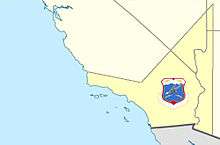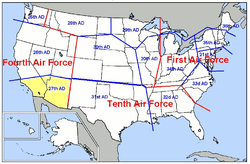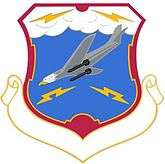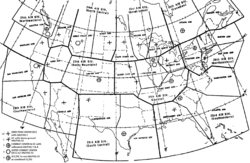27th Air Division
The 27th Air Division was a United States Air Force numbered air division and the geographic Air Defense Command region controlled by the 27th AD. Its last assignment was with Air Defense Command (ADC)'s Tenth Air Force, at Luke Air Force Base, Arizona. It was inactivated on 19 November 1969.

 The area of the Los Angeles Air Defense Sector (1960–6) and 27th Air Division (1966–69) was adjacent to the 26th, 30th, and 31st Air Divisions at the Four Corners | |
| Active | 1950–1959, 1966–1969 |
| Country | |
| Branch | |
| Role | Command of air defense forces |
| Part of | Air Defense Command |
| Insignia | |
| 27th Air Division emblem (Approved 23 July 1953)[1] |  |
Norton AFB
Activated as the 27 Air Division (Defense) on 7 September 1950, the unit was assigned to ADC for most of its existence,[note 1] the division's initial air defense area was southern California and later southern Nevada (and a small portion of Arizona by 1953).[1]
The 4705th Defense Wing was a temporary unit that absorbed the 1st Fighter-Interceptor Wing's personnel and equipment five days after it was organized in early 1952 at Norton Air Force Base.[2] These units included, for example, the 94th Fighter-Interceptor Squadron at George Air Force Base).[3] The wing was discontinued and the 94th FIS reassigned directly to 27th Air Division, which had reorganized at Norton in February,[1] one month later.[4]
In May 1958, the 27th AD directed a hostile intercept of a "declared unknown" aircraft (without proper IFF), but the "interceptor pilot remembered...that opening bomb bay doors was to be considered a hostile act only after declaration of an Air Defense Emergency or Warning Yellow or Red" (the SAC B-47 was on a Radar Bomb Scoring bomb run near the Los Angeles Bomb Plot.)[5] The 27th AD was designated 1 of 23 NORAD divisions effective 10 June 1958 by NORAD General Order 6.[5]:7

Rocky Mountain Division
The "27th Air Division (Rocky Mountain)" was to transfer to the midwest with command of 2 NORAD sectors (Reno and Denver Air Defense Sectors) during deployment of SAGE. In addition to a hardened Air Defense Direction Center at Stead Air Force Base for the Reno sector; NORAD's 25 July 1958 SAGE Geographic Reorganization Plan identified the Super Combat Center/Direction Center (SCC/DC) nuclear bunker for the division was to be at Denver, Colorado (cf. the bunkers later planned for the Cheyenne Mountain Complex and in a Cripple Creek mine). The division's general area was west-to-east from the western Nevada state meridian (near the Sierra Escarpment) to the Great Plains near Oakley, Kansas; and north-south from mid-Wyoming to just south of the Four Corners latitude. Existing Permanent System radar stations in the planned Rocky Mountain Division included the Fallon, Tonopah, and Winnemucca Air Force Stations (the atomic-powered "SAGE feeder station" in the Black Hills NF became operational in 1962);[6]:169 and facilities and cities to be protected by the division included the Salt Lake City military installations west of the Rockies and planned Titan missile launch complexes and an Air Force Plant at the Colorado Front Range. The Reno sector was activated 15 February 1959 and the AN/FSQ-7 at Stead Air Force Base[6]:135 was replaced by Backup Interceptor Control (BUIC) at Fallon Naval Air Station by 1970.
In February 1959, the Los Angeles Air Defense Sector was activated during the deployment of the Semi Automatic Ground Environment#Deployment (SAGE) as a subordinate unit of the 27th AD.[7] However, the Denver SCC/CC was cancelled in March 1959; so instead of moving from the Southwest United States to the interior (and the 28th Air Division then taking over as the Southwestern Air Division), the 27th Air Division was inactivated on 1 October 1959 (command transferred to the subordinate Los Angeles Air Defense Sector).
Luke AFB
Reactivated in January 1966 at Luke Air Force Base,[1] the 27th Air Division consolidation the Los Angeles and Phoenix Air Defense Sectors, and the division assumed the additional designation of 27th NORAD Region after activation of the NORAD Combat Operations Center at the Cheyenne Mountain Complex, Colorado. The Norton SAGE Direction Center closed in June 1966 (the Luke Direction Center was 1 of 6 still open in 1970).[6]:47 When the 27th AD was inactivated in 1969,[1] its mission, personnel and operations center at Luke were transferred to the 26th Air Division.[1][8]
Lineage
- Constituted as the 27 Air Division (Defense) in September 1950
- Activated on 20 September 1950
- Inactivated on 1 February 1952[note 2]
- Organized on 1 February 1952
- Inactivated on 1 October 1959
- Redesignated as the 27th Air Division and activated on 20 January 1966
- Organized on 1 April 1966
- Inactivated on 19 November 1969[1]
Assignments[1]
- Western Air Defense Force, 20 September 1950 – 1 October 1959
- Air Defense Command, 20 January 1966
- Fourth Air Force, 1 April 1966
- Tenth Air Force, 15 September 1969 – 19 November 1969[1]
Stations[1]
- Norton Air Force Base, California, 20 September 1950 – 1 October 1959
- Luke Air Force Base, Arizona, 1 April 1966 – 19 November 1969[1]
Components
Sector
- Los Angeles Air Defense Sector, 15 February 1959 – 1 October 1959[1]
Wings
- 1st Fighter-Interceptor Wing (attached)[1]
- March Air Force Base, California 20 September 1950 – 1 February 1952
- 78th Fighter Wing (Air Defense)[1]
- Hamilton Air Force Base, California, 15 September 1969 – 19 November 1969
- 4705th Defense Wing[4]
- Norton Air Force Base, California, 1 February 1952 – 1 March 1952
Groups
|
|
Defense Systems Evaluation Squadron
- Holloman Air Force Base, New Mexico, 15 November 1969 – 19 November 1959
|
|
Radar squadrons
|
|
See also
References
Notes
- until 1 December 1950, its parent Western Air Defense Force was part of Continental Air Command
- The simultaneous inactivation and organization in February 1952 represents only a change in the type of organization of the division between Table of Distribution and Table of Organization and had no practical effect on the unit.
Citations
- "Factsheet 27 Air Division". Air Force Historical Research Agency. 5 October 2007. Archived from the original on 24 October 2012. Retrieved 9 April 2014.
- Ravenstein, p. 6
- Maurer, pp. 138, 262
- Cornett & Johnson, p. 66
- Preface by Buss, L. H. (Director) (1 October 1958). North American Air Defense Command Historical Summary: January–June 1958 (Report). Directorate of Command History: Office of Information Services. "In May 1958, Western CONAD Region pointed out a weak area in the definitions of a hostile act uncovered in an incident in the 27th Air Division. A B-47 was declared unknown and intercepted, and then was observed opening its bomb bay doors prior to crossing Los Angeles. By the provisions of 55–6, the B-47 should have been declared hostile and destroyed. Fortunately, however, the interceptor pilot remembered the provisions of CONAD 55-3 which provided that opening bomb bay doors was to be considered a hostile act only after declaration of an Air Defense Emergency or Warning Yellow or Red. The actions of the bomber, CFWCR continued, were standard practice for SAC aircraft on radar bomb scoring runs. And when the aircraft was known to be friendly, the practice was not dangerous. However, in cases such as the one in the 27th, the aircraft could possibly be declared hostile and shot down."
- Winkler, David F; Webster, Julie L (June 1997). Searching the Skies: The Legacy of the United States Cold War Defense Radar Program (Report). Champaign, IL: U.S. Army Construction Engineering Research Laboratories. LCCN 97020912. Retrieved 23 April 2013.
With the exception of a BUIC III at Tyndall Air Force Base, ADC's BUIC III capability was mothballed. ... In 1975, reflecting a structural change in organization, ADC's acronym was changed to ADCOM, the Aerospace Defense Command. ... A reorganization in 1987 placed the site under the Southwest Air Defense Sector of the 25th Air Division. ... Luke-Williams Range/Ajo (A-9/NCC)...In 1961 Luke Range became a SAGE center. ... Z-247/J-29 – Phoenix/Humboldt Mountain/Cave Creek...A detachment of the Luke-based 4629th Air Defense Squadron came to this FAA operated site in late 1972 ... Air Defense Command (ADC) activated a direction center at Luke Air Force Base on 15 June 1959. This center controlled the Phoenix Air Defense Sector until disestablishment in 1966.
- Preface by Buss, L. H. (Director) (1 November 1959). North American Air Defense Command and Continental Air Defense Command Historical Summary: January–June 1959 (Report). Directorate of Command History: Office of Information Services.
- "Factsheet 26 Air Division". Air Force Historical Research Agency. 5 October 2007. Archived from the original on 10 November 2012. Retrieved 9 April 2014.
- Factsheet, 94th Fighter Squadron Archived 4 March 2016 at the Wayback Machine. Retrieved 11 March 2012
Bibliography
![]()
- Cornett, Lloyd H; Johnson, Mildred W (1980). A Handbook of Aerospace Defense Organization, 1946–1980 (PDF). Peterson AFB, CO: Office of History, Aerospace Defense Center. Retrieved 23 March 2012.
- Grant, C. L. "The Development of Continental Air Defense to 1 September 1954, USAF Historical Study No. 126" (PDF). Research Studies Institute, USAF Historical Division, Air University. Retrieved 17 August 2014.
- Leonard, Barry (2009). History of Strategic Air and Ballistic Missile Defense (PDF). Vol I. 1945–1955. Fort McNair, DC: Center for Military History. ISBN 978-1-4379-2131-1.
- Leonard, Barry (2009). History of Strategic Air and Ballistic Missile Defense (PDF). , Vol II, 1955-1972. Fort McNair, DC: Center for Military History. ISBN 978-1-4379-2131-1.
- Maurer, Maurer, ed. (1982) [1969]. Combat Squadrons of the Air Force, World War II (PDF) (reprint ed.). Washington, DC: Office of Air Force History. ISBN 0-405-12194-6. LCCN 70605402. OCLC 72556.
- Ravenstein, Charles A. (1984). Air Force Combat Wings, Lineage & Honors Histories 1947–1977. Washington, DC: Office of Air Force History. ISBN 0-912799-12-9.
- Redmond, Kent C.; Smith, Thomas M. (2000). From Whirlwind to MITRE: The R&D Story of The SAGE Air Defense Computer. Cambridge, MA: MIT Press. ISBN 978-0-262-18201-0.
